Which septic tank to choose: rating of the best sewage treatment plants
Installing a septic tank is a practical way to solve the problem of drainage in the arrangement of a local sewage system. But, you see, among the variety of ready-made designs it is sometimes not easy to make a choice.
To simplify the task, we suggest that you familiarize yourself with an overview of the main types of treatment facilities and popular models from leading manufacturers. We will tell you which septic tank to choose based on the features of its operation, and outline the main parameters of the device that must be considered when buying.
For a better understanding of the issue, we supplemented the information with photographs of various models of utilizers, as well as schemes for their installation.
The content of the article:
Models of utilizers and their features
Septic tank is a waterproof design consisting of one or more sections or divided into two or three compartments, cameras. But any sewage treatment plant has its own characteristics.
Therefore, in order to correctly select a utilizer, it is necessary to analyze the types of equipment available on the market, to understand septic tank, the principle of their action and determine for themselves the appropriateness of applying this or that model.
Types of materials used
Septic tanks, which are the main element of local sewage, are classified according to various criteria.
The competent choice of a septic tank largely determines the material of its manufacture, each of which has its pros and cons:
- Reinforced concrete rings - prefabricated structures have high reliability and corrosion resistance. But their installation is problematic to perform without the involvement of special equipment.
- Monolithic concrete structures, for filling the walls and bottom of which formwork is being built.
- Brick and foam block constructionserected from the bottom of the pit, the bottom and walls of which are abundantly sealed with clay or modern coating compositions.
- Steel tanks - They are famous for their affordable price and high mechanical strength. But steel alloys are susceptible to corrosion processes, and therefore, the designs made from them require waterproofing.
- Polymer containers - differ in small mass and relative cheapness. But the polymer under the influence of low temperatures is prone to cracking, and is also vulnerable to damage by rodents.
- Fiberglass - The strong and lightweight material is famous for chemical neutrality, and therefore containers made of fiberglass are most practical and durable.
Regardless of the type of material chosen, the main thing is that it is strong and leakproof enough to prevent untreated sewage from seeping into the surrounding soil.
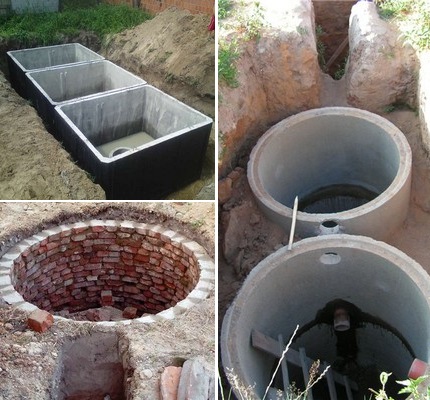
The complex of implemented functions
If you focus on the complex of implemented functions, the septic tanks on sale are of three versions:
- Cumulative type. A robust sealed tank may include one chamber or two interconnected sealed wells. Such facilities need regular timely pumping.
- Septic tanks. Equipped with soil post-treatment systems, as capable of purification only 70-75%. They are a structure of one or more sections. The process of wastewater treatment in them is carried out by separating the liquid and solid components, followed by fermentation using anaerobes.
- Stations of deep biological treatment. The cleaning design including several sections or chambers. Designed in such a way that the waste falling inside it is decomposed in stages by chemical, biological and mechanical methods. Residual organics from such treatment tanks may be discharged directly into a body of water or soil.
The simplest drives among the listed models. The principle of operation of such structures is that the wastewater collected in the tank is naturally stratified: heavy particles settle, and the lightened liquid rises.
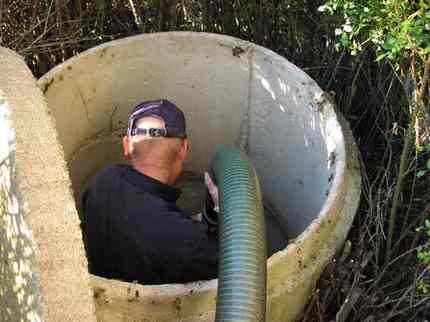
AT septic tanks insoluble sediment is naturally separated from water during sedimentation. Sumps are supplemented by infiltrators designed for disposal of clarified wastewater into the ground.
Infiltrators, which are chambers devoid of a bottom, perform the function of aeration platforms. The effluents coming into them undergo additional purification, passing through a soil filter before discharge into the environment.
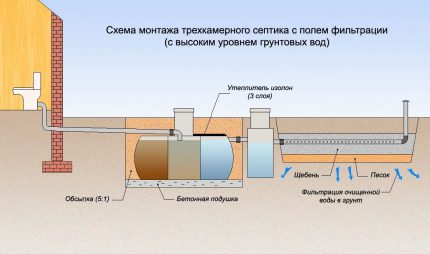
In deep-treatment facilities, several methods are involved at once to ensure that the waste decomposes in stages: initial settling of solid fractions, subsequent bioprocessing of organics, chemical treatment of the contents, and filtration of purified water.
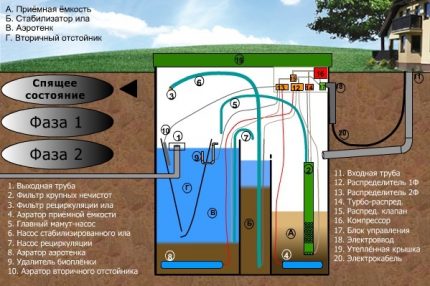
With the help of deep cleaning stations, 95-98% of the clarified, clarified and disinfected waste masses become neutral and suitable for discharge into the gutters.
Subtleties of choosing the optimal septic tank
On the treatment plant selection, first of all, the conditions on a particular object and the needs of residents influence it.
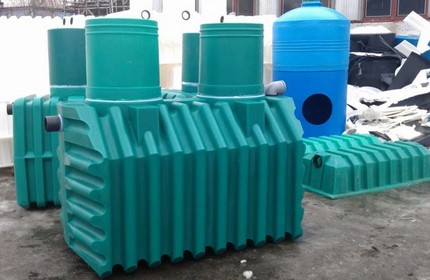
The cost of any model consists of the following parameters:
- case material;
- volume and number of connected containers;
- applicable technology for waste processing;
- the availability of additional equipment.
Depending on the type of construction, models may include: compressors and drainage pumps, filters and float level meters, automatic control systems.
Compressors are used in biological treatment plants to supply oxygen that oxidizes the waste water, which is also needed for the life of aerobes.
Drainage pumps are required if there is a need to stimulate the movement of effluents within the septic tank or to discharge treated water if the septic tank is located below the discharge point.
The advantages of a factory product over a home-made
Homemade tanks made of tires, bricks or concrete ringswill cost cheaper. But their construction will require a lot of time and effort.
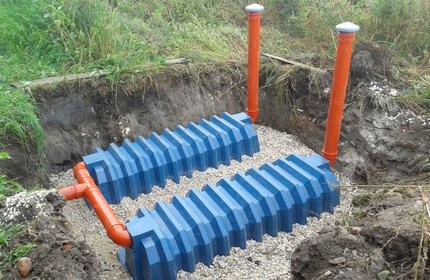
Depending on the operating mode, one can construct from the improvised building materials both the simplest design of the accumulative type and the installation of series-connected settling tanks, providing stepwise clarification of the waters.
Choosing a finished design, you get a guarantee that it complies with building and environmental standards.
Ground Type and Groundwater Depth
When determining how a septic tank is best installed on your site, focus on the geological conditions of the area.
When choosing a sewage treatment plant based on a septic tank with an infiltrator or an absorption well, keep in mind that groundwater should run below the conditional bottom of the soil treatment system by at least 1 m.
Note that the discharge of purified water into the soil is possible if sands, gravel and pebble soils, sandy plastic sandy loams lie below the post-treatment system.
In addition to infiltrators and absorption wells, filtering fields are also used in the post-treatment of wastewater. This is a drainage system assembled from perforated pipes, drains, with a sheath of filtering gravel and geotextiles.
If the filtration field is located above the treatment plant, then pumps are used to move wastewater along drains.
On clay soils, the installation of after-treatment systems is pointless, because clays, loams and hard sandy loam do not pass and do not absorb water. This means that disposal in the soil will not be carried out, as a result, the septic tank will flood and stop working.
In such situations, discharge is carried out through pressurized pipelines into the gutters or into centralized sewer networks.
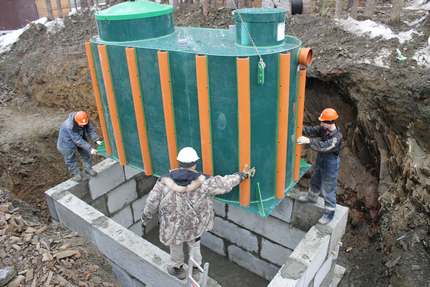
A high level of groundwater occurrence or their significant rise during floods creates certain problems in the operation of autonomous treatment facilities.
For such areas, the acceptable options are:
- sealed storage tanksinvolving pumping and removal of effluents;
- VOCs, the design of which provides for the forced diversion of the cleaned liquid.
The most affordable option for areas with a high groundwater table is the use of polymer reservoirs that involve bio-treatment with subsequent discharge to the reservoir.
In this case, the purified component of the effluent is either pumped to the centralized networks by a pump or pumped out by sewers, but much less frequently than from a conventional reservoir.
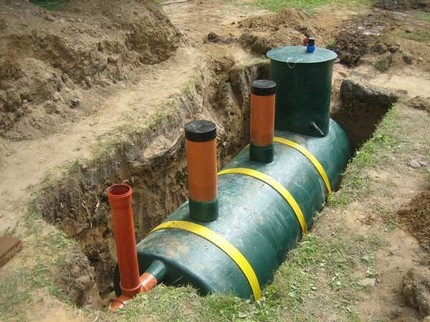
For comparison: 1 m2 sand per day can absorb up to 90 liters of water, sandy loam - up to 50 liters, loam - 25 liters, and clay - only 5 liters.
Volume and dimensions of a septic tank
The volume of the receiving tank or section is calculated based on the average daily rate of effluents per household.
The basis is taken that the daily consumption when using a standard set of plumbing is about 200 liters per person.
According to the accepted standards, the sewer store must contain the volume of effluents from each of the residents equal to the three-day norm.
So, for a family of four, the volume of a septic tank should be: 4 people. x 200 l x 3 days. = 2.4 cubic meters. If the house is often visited by guests, when calculating the tank, they make an additional supply of volume by another 20-30%.
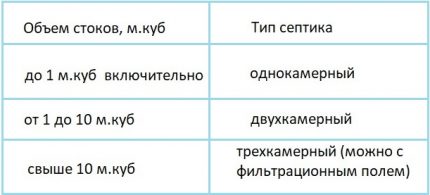
In factory-made models, manufacturers indicate the number of people for whom they are designed and the performance of structures.
The optimal depth of the tank varies from 1.5 to 3 meters. When choosing models of greater depth, keep in mind that this may cause difficulties in pumping out the contents with a waste water machine.
Wastewater Treatment Plant Performance
To ensure trouble-free operation of the system and prevent overcrowding of the tank, it is necessary to focus on the type of housing and the performance of the model.
No. 1 - models for seasonal homes
If you plan to visit your country house only on weekends or to dwell in it only in the warm season, it is not rational to establish a multi-chamber production complex.
Prudent owners of cottages to equip their sites, if the average daily volume of effluents does not exceed one cubic meter, choose mainly single-chamber low-performance drives.

Due to their low weight, compact mini-septic tanks are convenient to transport and dig into the foundation pit, using their own resources and not resorting to the services of special equipment.
No. 2 - septic tanks for year-round houses
For sites on the territory of which a year-round stay is expected, it is advisable to establish a treatment plant that uses all methods of wastewater treatment.
An alternative is the right to serve as septic tanks with soil treatment systems, if the groundwater horizon is low in the area of the sewage system.
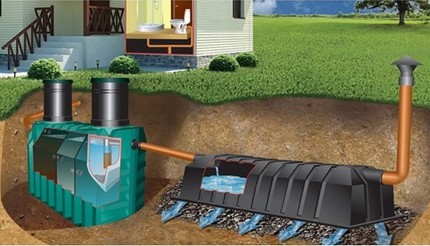
To make autonomous sewage function more efficiently, aerobic and anaerobic bacteria are often used when it is launched.
To do this, bacteria are placed inside the tanks that “eat” the organics. Biological decomposition of waste allows to bring household waste water to the state of industrial water.

Deep cleaning plants are ideal for arranging sites located in close proximity to a natural body of water.
After all, treated effluents that have passed through stations with a high percentage of filtration can be discharged into any reservoir.
Rating of domestic offers
The production of treatment facilities for local sewers on the Russian market began only a few decades ago. But over the years there have been many manufacturers specializing in this area.
The models of some of them are just a copy of the leading European brands, but still the bulk are truly unique buildings and structures.

According to the results of a survey of consumers who actively use household wastewater purifiers in their sites, we compiled a rating of septic tanks:
- Eurobion. Stations are the result of many years of work by specialists of the Yubas production association. Thanks to the use of innovative membrane technology and a rhythmic aeration tank, the stations can be operated even with prolonged shutdowns of the sewer system.
- Aster. Septic tank settlers of the Unilos trademark guarantee removal of harmful components up to 75%. There are several modifications on sale depending on the number of consumers. The station, supplemented by a compressor, performs cleaning in several stages, so that sanitary wastewater passed through it can be dumped into a ditch.
- Tank. Products manufactured by Triton-Plastic. The model range includes compact tanks with a capacity of 600 l / day, and high-performance facilities designed for 1200 l / day. In their parameters, they are identical to classic sewage treatment plants with multi-stage waste treatment.
- Triton. Another popular product of this company. In the model range of septic tanks of this brand, several types are presented, differing in configuration and method of cleaning. Products of the class "micro" and "mini" are designed for a volume of 450 and 750 liters, and storage tanks of the type with the letter designation "H" and "T" - for a volume of 10 thousand liters and above.
- Tver. The products of the Engineering Equipment trading house carry out wastewater treatment not only mechanically, but also biologically. The stations are equipped with a four-level wastewater clarification system and are designed for waste treatment from 750 to 1.5 thousand cubic meters per day.
- Topas. Products manufactured under this brand are characterized by low energy consumption. Four-chamber aerobic devices have a cleaning rate of up to 98%.
A distinctive feature of the products manufactured by Triton-Plastic is the large wall thickness and the presence of stiffeners, thanks to which they easily withstand large external loads.
And also do not emerge even under the influence of floods, if their presence was not taken into account when choosing a design.
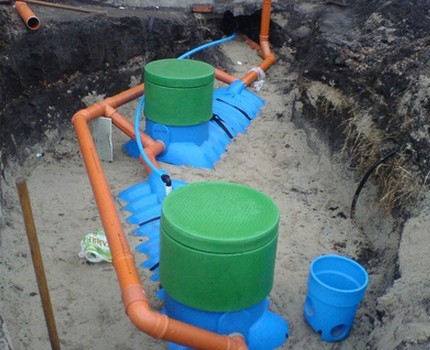
No less popular are the treatment facilities of a manufacturing enterprise "Leader". Polypropylene tanks of this brand carry out three stages of cleaning: mechanical, aerobic and biofiltration.
Well established and septic tanks Rostockmanufactured by EcoProm. The manufacturer specializes in the production of anaerobic treatment devices.
But, since the percentage of cleaning inside the chambers reaches only 65-70%, for the full-fledged operation of the structures it is necessary to install drainage tunnels.
The presence in the model lines of the listed manufacturers of structures with various parameters makes it possible for any consumer to make a rational choice, based on the optimal price / quality ratio.
Conclusions and useful video on the topic
The video discusses the principles of operation of different septic tanks and lists practical tips for choosing the optimal unit for domestic use:
Advantages and disadvantages of various cleaners:
Which option is suitable for organizing an autonomous sewage system is up to you. The main thing, remember that only a correctly selected and correctly installed septic tank can become an effective means of recycling and cleaning household waste.
Looking for a septic tank for a private house? Or have experience using such installations? Please leave comments on the article, ask questions and share your opinion on the operation of septic tanks.

 Which septic tank is better for home: a comparison of popular treatment plants
Which septic tank is better for home: a comparison of popular treatment plants 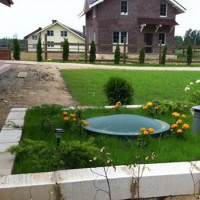 How to choose a septic tank for giving: an overview and tips for choosing the best option
How to choose a septic tank for giving: an overview and tips for choosing the best option 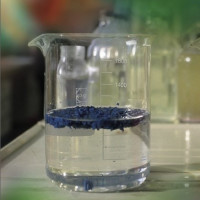 Coagulant for wastewater treatment: how to choose + rules of use
Coagulant for wastewater treatment: how to choose + rules of use  Septic “Uponor”: device, advantages and disadvantages, review of the model range
Septic “Uponor”: device, advantages and disadvantages, review of the model range 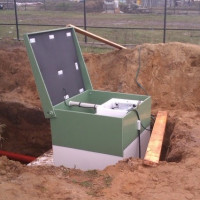 Overview septic tank for giving “Topas”: principle of operation, device, advantages and disadvantages
Overview septic tank for giving “Topas”: principle of operation, device, advantages and disadvantages 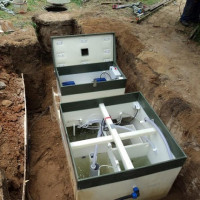 Septic tank for high groundwater: methods for determining the water level and recommendations for the selection of a septic tank
Septic tank for high groundwater: methods for determining the water level and recommendations for the selection of a septic tank  How much does it cost to connect gas to a private house: the price of organizing gas supply
How much does it cost to connect gas to a private house: the price of organizing gas supply  The best washing machines with dryer: model rating and customer tips
The best washing machines with dryer: model rating and customer tips  What is the color temperature of light and the nuances of choosing the temperature of the lamps to suit your needs
What is the color temperature of light and the nuances of choosing the temperature of the lamps to suit your needs  Replacement of a geyser in an apartment: replacement paperwork + basic norms and requirements
Replacement of a geyser in an apartment: replacement paperwork + basic norms and requirements
We also forgot to mention the autonomous sewage Kolo Vesi. Modern Finnish technology, which allows to treat wastewater by 98%. Such drains can be discharged onto the terrain, into the ground or used for irrigation without additional purification. The device has a simple and reliable design, great for installation in summer cottages, near a house or a cottage. Kolo Vesi is included in the class of biological treatment plants. It can be installed in any soil, the model is volatile. Suitable for both temporary and permanent residence.
Dear Tamara, let's not fantasize. Kolo Vesi has nothing to do with Finland and Finnish technology. This is just a marketing gimmick. And the Kolo Vesi station cannot be ranked as a deep biological treatment station, such as the installations Topas, Astra, BioDeca, Genesis. Kolo Vesi can most likely be attributed to the stations of the previous generation - the septic tank category.
Well, the cost of septic tanks is generally impressive ... Especially new biostations. Although for Moscow this may be a bit ...
So of all the listed KoloVesi the most expensive. At us in Novosibirsk nobody buys them at all.
Oh yes, it’s very difficult to choose a septic tank. It’s good that my husband did this, he is at least a little technical savvy. As a result, they put Alta Bio 5 on us - they installed everything on a turn-key basis, told how to use it. For a little over a year now, everything has been working well. In general, I read that the correct operation of the septic tank and, in general, its service life are directly related to the correct installation. Here, the neighbors in the SNT were initially set up somehow somehow wrong, and there were some problems with the septic tank, then they reinstalled them again, and everything seemed to be normal. So, pay attention - from whom you order the installation.
Why pay for the station if there are more reliable solutions, without hemorrhoids and costly maintenance? We set ourselves a regular septic tank BIO 3.0. It is installed in 7-8 hours. They put themselves - 2 people - me and father-in-law. No tractor needed. You can place a septic tank in a small area if you use an infiltrator.
Simple service.Without connecting to electricity. It is enough to pump out once in 2 years. Winter preservation is not required. Service life more than 50 years - the manufacturer declares. But the guarantee was given 10 years - this is more than others. Fiberglass septic tanks do not decompose like plastic. They remain airtight - it’s not realistic to break them.
I do not advertise anyone, I chose from 3 - Flotenk, Septobak and Baikal. I can write a treatise about everyone. Chose as a result after visiting the production. Do not be too lazy to see everything live - and there will be no questions.
Good day, Andrey. Do not mislead people.
I answer you why people pay money:
1. Volatile stations treat sewage up to 98%, which, according to sanitary standards, allows them to be dumped into an open ditch;
2. Maintenance of septic tanks comes down to cleaning the sludge chamber from the sludge, and it is possible to conduct it yourself. Frequency once a year or once every two years. Pumping / calling with a cesspool machine is not performed as such.
3. An excavator is required in case of installation of overall septic tanks designed for living in a house of 12 people or more. Running models for 6-8 people are installed without the use of equipment.
4. Plastic does not decompose just like fiberglass, and the strength of the container in both versions depends on the number of joints, but not on the material.
Disadvantages of the septic tank BIO 3.0 and similar models without connecting to electricity:
1. The maximum level of purification is 60%. It is forbidden to dump sewage with this level of cleaning into a ditch, therefore arrangement on a site of a filtration well is required.
2. Installation in a small area with a well is not possible, there is a high risk of bactericidal contamination of water.
3. Requires pumping out drains and calling with a cesspool machine at least once a year. In the autumn / spring period, the frequency of the call depends on the height of the groundwater in the area. If high and filter well If it does not cope with the daily discharged volume, then the call of expensive specialists is possible once a month.
If you choose a bioremediation station, then there is little that can be compared with Topas Automix. They set it up at home, and then the neighbors set it up. Very satisfied! When it is not possible to connect to the central sewage system, this is an ideal outlet.